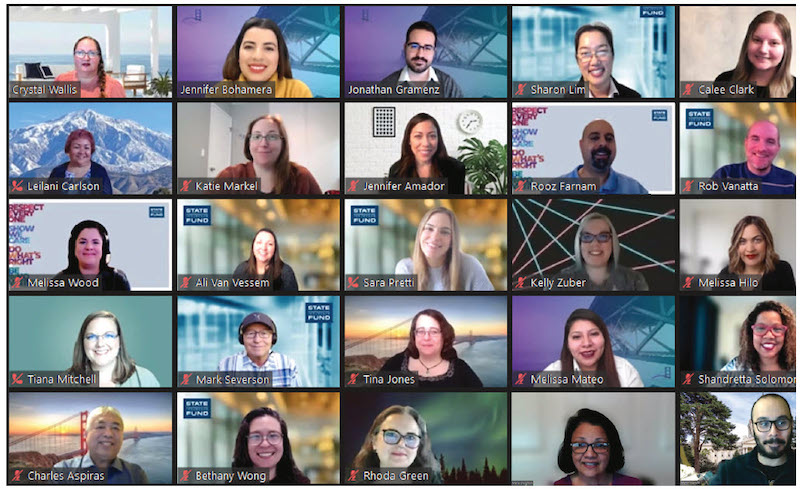
As a not-for-profit state agency providing essential insurance services, State Compensation Insurance Fund has important work to do. When the pandemic hit, it couldn’t put the learning and training of its employees on hold.
Fortunately, for those it serves, the organization had no intention of quitting or slowing down. Instead, it looked for ways to ensure a continued secure financial structure and honed in on creating a customer-centric culture that also empowers employees. The organization also focused on helping businesses in its home state of California improve workplace safety and reduce the overall cost of risk, while providing benefits to the injured employees of its policyholders.
With such an ambitious list of goals, it’s impressive that State Fund was able to deliver on its objectives. It’s learning and development programs were a key reason it was able to do that, earning the organization a place in the APEX Awards Top 5 for the first time.
A STRONG START
A robust New Employee Onboarding program played a major role in the organization’s success, according to Senior Learning & Development Managers Mandie Craver and Karel Davis. This week-long program for all new employees starts on the first day of employment (the first Monday of each month). In 2021, approximately 200 employees attended—about half of pre-pandemic hiring numbers.
“Onboarding is our one chance to make a good first impression, so we engage new employees even before they start by giving access to our pre-boarding site, then dive in with more details, discussions, presentations, videos, and activities to help them understand the importance of the work we do and embrace our mission, vision, and culture that drive our goal to be the Workers’ Compensation carrier of choice and employer of choice,” Craver and Davis explain.
New Employee Onboarding includes:
- Classroom training to ensure content consistency and internalization of the learning. During the pandemic, classroom training has been in a virtual environment.
- Peer activities to encourage collaborative learning and network building.
- Videos to engage students while providing information.
- One-on-one meetings with a benefits specialist to ensure new employees have the information needed to make decisions.
- Post-training check-ins to ensure new employees have the tools and support they need to be successful.
State Fund surpassed its target goal for controllable separation of less than 5 percent with the current attrition rate of 1.6 percent—even during the pandemic. This is a 92 percent decrease from the pre-onboarding attrition rate of 19 percent within the first two years of hiring.
“Supervisors report that their employees are excited to work for State Fund and have an understanding of the work we do,” Craver and Davis note. “New employees have stated that they take extra care to always do their best because they understand the impact their actions have on our customers. And our engagement scores continue to surpass the benchmark of 74.4 percent for other finance and insurance industry scores, with a 2021 score of 83.5 percent.”
CREATING A VIRTUAL CAMPUS
In addition to converting all its training to virtual delivery due to the pandemic, State Fund adopted a virtual campus for training, meetings—and for fun. Upon entering the virtual campus for the first time, employees were able to design their own avatar to navigate and interact with their colleagues in many ways, including instant messaging and live audio.
For example, State Fund’s Emerging Leader Program, which ordinarily would have met in-person throughout the year for classes, activities, and social events, “used the virtual campus to make events more engaging and interactive—and as a nice break from Zoom,” Craver and Davis point out. The organization also offered a series of open presentations to provide information and updates on topics such as Fraud 101, Finance and Investment Updates, COVID-19 Building Safety Measures, Retirement Planning, and State Fund’s Efforts to Become More “Green.”
“Attendance at these presentations often was higher than expected, possibly because of the virtual world environment where everyone could ‘see’ their friends and co-workers,” say Craver and Davis.
The organization adopted the use of an interactive whiteboard for both collaboration and classroom activities to give everyone involved an opportunity to participate. For example, the whiteboard was used to support State Fund’s Design Challenge sessions by allowing participants to apply the brainstorming techniques in a virtual collaboration space.

DELIVERING “EXPERIENCES BY DESIGN”
The design thinking process can help an organization become more effective and efficient in how it develops and implements new ideas. For that reason, State Fund decided to teach this process to employees.
“Experiences by Design is one of our most effective training programs due to the immense positive effect on our organization, and there is no end in sight. This course teaches the design thinking process to participants, both individual contributors and leaders, and is driven by one of our core values—‘Be Innovative,’” say Craver and Davis. “The class allows participants to envision procedures or processes they would like to change and things they would like to implement, and to problem solve to eliminate pain points in their daily work.”
To reinforce what students learn in the class, State Fund hosts Design Challenges, where teams of employees tackle the problems or barriers they have identified and seek solutions to make work easier, more efficient, and more effective. Design Challenges provide ways for employees to take control of their work and their environment by solving the problems they have identified.
“Since the launch of Experiences by Design, employees across the organization have used design thinking to solve problems,” say Craver and Davis. “Executives and leaders have used the training to help identify the most important initiatives to focus on for the coming year. Participants in the Emerging Leader Program use the technique to research and create plans for their Action Learning Projects, which can solve large-scale problems, or implement ideas that impact a department, location, or the whole organization.”
The effect on State Fund of this program has been profound, with many problems solved and more than 20 processes implemented to help the organization become more efficient in its work, including:
- Implementation of a new Chatbot to help customers End information quickly and eliminate frustration.
- Development of a new process for the storage and retrieval of subpoenaed records. The process has improved the security of these records and allows attorneys and claims adjusters quick access, which saves time and helps move claims toward closure.
- Creation of a new process in the Billing & Collections department, which has helped employees become more efficient.
WELL-BEING AND WORK
During the pandemic, State Fund made a unique investment to aid in the well-being of its employees as many parents struggled to balance work responsibilities with parental and home schooling responsibilities. “To help ease some of the stress for parents, we created a Student Help Program for employees with school-aged children in grades pre-K through high school,” Craver and Davis explain. “We hired 40 college students, all majoring in education, child development, or similar subjects, and we trained them to ‘teach’ in Zoom classrooms created for each grade. We developed curricula, including grade-appropriate math, history, reading, art, music, games, virtual held trips, and more. These sessions allowed participating children to engage and socialize with other children of the same age, and kept them moving forward in their schoolwork.”
Over the course of the 49-week program, student assistants provided 6,006 hours of group instruction and 3,758 hours of one-on-one tutoring, allowing their parents to focus on their work. Using student assistants to facilitate the program instead of employees was a substantial cost savings of $292,000. Note Craver and Davis, “The improved well-being and morale of our employees, along with the completion of necessary work, was priceless.”
FRESH THINKING FOR THE FUTURE
In a post-pandemic world, technological advancements, and Ending fresh ways to use those technologies, will be of the utmost importance, Craver and Davis believe. They point to greater use of artificial intelligence (Al) as an example of exciting new technology that has the capacity to enhance services for both customers and employees.
The organization also sees the potential to use AI and other technologies to lessen its carbon footprint. “State Fund must leverage technologies that are more effective in order to deliver impactful training to employees, while still doing our part to reduce waste,” Davis and Craver say. “The pandemic has helped us realize that people congregating in shared spaces, such as office buildings, is no longer necessary, and actually presents undue risk.”
Ultimately, they say, that means “L&D must adapt and deliver training in ways that work for all employees, regardless of location, and in a cost-conscious way.”


